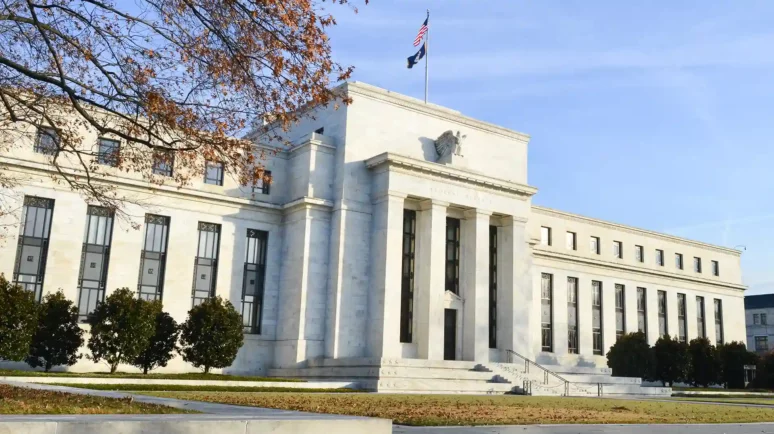Projected ECB Interest Rate in Five Years: Lagarde & Co. To Start Rates Cut This Summer?

Where do we expect the eurozone interest rates to be in five years?
Key Takeaways
- The European Central Bank left the interest rates unchanged in April.
- The eurozone bank is expected to cut rates in summer 2024.
- The bank’s next decision on monetary policy will be on June 6.
- What is the impact of interest rates on cryptocurrencies?
The European Central Bank kept interest rates unchanged again in April again but anticipated it will be the first big central bank to cut rates this year.
The ECB, headquartered in Frankfurt, kept the interest rates for the main refinancing operations, marginal lending facility, and deposit facility steady at 4.50%, 4.75%, and 4%, respectively. This decision marks the fourth consecutive meeting where the central bank has held eurozone interest rates steady.
Since July 2022, the ECB has implemented 450 basis points, or 4.5 percentage points, worth of rate hikes, initiating its first interest rate hike in 11 years.
Rates Remain Unchanged
In a statement , the ECB’s Governing Council acknowledged the persistent deceleration of inflation, primarily driven by lower food and goods prices.
It noted: “Most indicators of underlying inflation are showing signs of easing, accompanied by a gradual moderation in wage growth. Meanwhile, businesses are absorbing a portion of the increased labor costs within their profit margins.”
Despite restrictive financing conditions and the lingering impact of past interest rate hikes on demand, which are contributing to downward pressure on inflation, the Council highlighted robust domestic price pressures that are keeping service price inflation elevated.
The Governing Council emphasized its belief that the current ECB interest rates are playing a significant role in the ongoing disinflationary process.
It stated its commitment to maintaining policy rates at sufficiently restrictive levels for as long as necessary. However, it also signaled openness to adjusting the level of monetary policy restriction if underlying inflation dynamics and the effectiveness of monetary policy transmission mechanisms indicate a sustained convergence towards the inflation target.
The Council reaffirmed its data-dependent and meeting-by-meeting approach, refraining from committing to a predetermined rate path.
There was no further news about ECB’s outlook from that which the institution outlined in December.
Despite acknowledging a recent dip in inflation, the ECB said it was likely to rebound in the near term, with a projected gradual decline throughout the next year as it approaches the 2% target in 2025.
The ECB’s projections indicate that headline inflation will average 5.4% in 2023. After that, it will go to 2.7% in 2024, 2.1% in 2025, and 1.9% in 2026. It signals a downward revision from the September estimates of 5.6% for 2023 and 3.2% for 2024.
Data from the end of November revealed a surprise slowdown in the Eurozone’s consumer price index, rising by 2.4% year-on-year compared to 2.9% in October.
Regarding economic growth, the Governing Council anticipates a subdued near-term outlook, with growth expected to increase from an average of 0.6% in 2023 to 0.8% in 2024, and further to 1.5% for both 2025 and 2026. These figures represent a downward revision from the September forecasts of 0.7% in 2023 and 1.0% in 2024.
Policymakers Confident To Cut
European Central Bank President Christine Lagarde reiterated the importance of a “data-dependent” approach to interest rate decisions, but she also hinted on Thursday that some members of the Governing Council are already leaning towards a rate cut.
Addressing questions following the ECB’s decision to maintain the interest rates on the main refinancing operations, the marginal lending facility, and the deposit facility at 4.50%, 4.75%, and 4.00%, respectively, Lagarde’s remarks further fueled expectations of a rate cut at the June meeting.
During a post-decision press conference, Lagarde stated: “A few members expressed confidence in the possibility of interest rate cuts, based on the limited data available for April.” However, she noted that these members ultimately aligned with the consensus reached by the majority of euro area policymakers.
The decision was accompanied by a somewhat dovish tone in the policy statement, with a new sentence added. The ECB stated, “If the Governing Council’s updated assessment of the inflation outlook, underlying inflation dynamics, and the effectiveness of monetary policy transmission were to increase its confidence in sustained convergence towards the inflation target, it would be appropriate to reduce the current level of monetary policy restriction.”
Despite these indications, the ECB emphasized that it is not making any preemptive commitments regarding future decisions.
Similar to the previous meeting, Lagarde highlighted that the ECB will have significantly more data available by the June meeting, which was not accessible prior to the current decision-making process.
Inflation Remained Unchanged In April
Introducing the European Central Bank (ECB)
The European Central Bank (ECB) serves as a central component within the Eurosystem and the European System of Central Banks (ESCB), making it one of the seven institutions of the European Union (EU). It holds a position of immense significance on the global stage as one of the world’s foremost central banks.
The ECB Governing Council assumes the responsibility of formulating monetary policy for both the Eurozone and the European Union. It manages the foreign exchange reserves of EU member states, conducting foreign exchange operations, and defining the intermediate monetary objectives and key interest rates within the EU.
To execute these policies and decisions, the ECB Executive Board operates under the authority of the Governing Council and may issue directives to the national central banks as needed. Additionally, the ECB possesses the exclusive authority to authorize the issuance of euro banknotes, while the issuance of euro coins by member states requires prior approval from the ECB. The ECB also oversees the functioning of the TARGET2 payments system.
Established in May 1999 through the Treaty of Amsterdam, the ECB has the crucial mission of ensuring and preserving price stability. Subsequently, on December 1, 2009, the Treaty of Lisbon came into effect, officially designating the ECB as an EU institution.
Eurozone Expansion
Initially, the ECB was established to serve the Eurozone, consisting of eleven member countries. Over time, the Eurozone expanded to include Greece in January 2001. It also added Slovenia in January 2007, Cyprus, and Malta in January 2008. Furthermore, Slovakia in January 2009, Estonia in January 2011, Latvia in January 2014, Lithuania in January 2015, and Croatia in January 2023.
Currently, to lead of the ECB is President Christine Lagarde and the bank’s headquarter is in Frankfurt, Germany. Before its new headquarters, it operated from the Eurotower.
The ECB operates in direct accordance with European Union law. Its €11 billion capital stock is collectively owned by all 27 central banks of EU member states as shareholders. The initial capital allocation key, based on the population and GDP of member states, was established in 1998 but has since undergone adjustments. Notably, shares within the ECB are non-transferable and cannot serve as collateral.
ECB Interest Rates
The key interest rates are instrumental tools the ECB uses within its operational framework to preserve price stability within the euro area.
These rates hold significant importance in conducting monetary policy, as they directly impact the cost of borrowing for various economic entities. These include governments, businesses, and households, both in capital markets and the market for bank loans. Furthermore, they influence the returns on various saving instruments, such as bank deposits.
Consequently, the ECB’s monetary policy decisions have a far-reaching impact on the spending, saving, and investment choices of households and businesses. It ultimately affects overall economic activity and, in turn, inflation rates.

The ECB maintains three key interest rates:
Main Refinancing Operations (MROs) Interest Rate
ECB establishes this rate to provide the banking system with weekly liquidity injections. It determines the cost incurred by credit institutions when borrowing funds from the ECB for one week.
Deposit Facility Rate
The ECB also sets the rate for the deposit facility. This dictates the interest paid to credit institutions for their overnight deposits held at the central bank. Notably, the deposit facility rate remained in negative territory from 2014 until July 2022.
Marginal Lending Facility Rate
This rate represents the cost borne by credit institutions when they borrow money overnight from the ECB.
These interest rates are pivotal tools in the ECB’s pursuit of its monetary policy objectives. They significantly influence the broader economic landscape and inflation dynamics.
Eurozone Interest Rate Projections For The Next 5 Years
Given the multitude of uncertainties currently in play, formulating a realistic forecast for ECB interest rates over the next five years presents a considerable challenge. Nevertheless, the European Central Bank itself has offered projections extending as far as 2025 in its survey of professional forecasters.
Trading Economics anticipated a decrease to 2.75% in 2024 and a further decline to 1.5% in 2025, based on their econometric models.

The Influence Of Interest Rates On Cryptocurrency
Cryptocurrencies, Bitcoin included, have demonstrated remarkable resilience even in the face of rising interest rates. Notably, Bitcoin experienced significant growth, with a surge of 2,000% observed during the years 2015 and 2016.
However, it is crucial to recognize that elevated interest rates can produce diverse effects on the cryptocurrency market. Some experts argue that persistent high inflation, rising gas prices, and increased energy costs linked to higher interest rates may potentially reduce risk appetite. This would thus create challenges for cryptocurrencies.
Central Banks And Their Impact On Cryptocurrencies
Central banks wield significant influence in shaping economic conditions as they directly impact money circulation and financial market stability. Their ability to adjust interest rates has a direct bearing on borrowing rates for financial and banking institutions.
In response to widespread inflation, major central banks in developed economies, such as the Fed, the ECB, and the BoE have chosen to raise interest rates.
It is worth noting the increasingly intertwined relationship between cryptocurrencies and these macroeconomic and monetary shifts. The decisions to raise interest rates, particularly by the Fed, have immediate repercussions for cryptocurrency markets.


